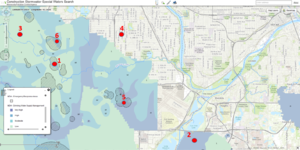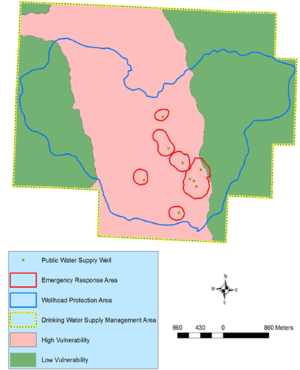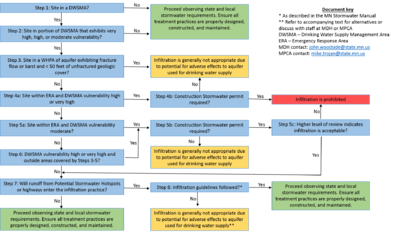
Stormwater and wellhead protection
This page provides guidance and recommendations for determining the appropriateness of infiltrating stormwater in a Drinking Water Supply Management Area (DWSMA). For more information on source water protection see Minnesota Department of Health.
Contents
Definitions
The figure at the right illustrates protection designations used to manage public water supply wells that have wellhead protection plans.
- Drinking Water Supply Management Area (DWSMA) - the surface and subsurface area surrounding a public water supply well, including the wellhead protection area, that must be managed by the entity identified in a wellhead protection plan. This area is delineated using identifiable landmarks that reflect the scientifically calculated wellhead protection area boundaries as closely as possible.
- Drinking Water Supply Management Area Vulnerability. An assessment of the likelihood that the aquifer within the DWSMA is subject to impact from overlying land and water uses. It is based upon criteria that are specified under Minnesota Rules, part 4720.5210, subpart 3.
- Emergency Response Area (ERA). The part of the wellhead protection area that is defined by a one-year time of travel within the aquifer that is used by the public water supply well (Minnesota Rules, part 4720.5250, subpart 3). It is used to set priorities for managing potential contamination sources within the DWSMA. This area is particularly relevant for assessing impacts from potential sources of pathogen contamination because this time of travel is believed to closely correspond with the survival period of many pathogens.
- Public water supply well – a drinking water well as defined in Minnesota Statutes, section 103I.005, subdivision 21, that serves a public water supply.
- Time of travel - means the amount of time over which groundwater will move through a portion of an aquifer to recharge a well in use. Note this definition does not consider travel time within the unsaturated (vadose) zone.
- Vulnerable public supply well – a public water supply well is vulnerable if:
- the well water contains ten (10) milligrams per liter or more nitrate plus nitrite nitrogen;
- the well water contains quantifiable levels of pathogens as defined in part 7040.0100, subpart 26, or chemical compounds that indicate groundwater degradation as defined in Minnesota Statutes, section 103H.005, subdivision 6;
- the well water contains one tritium unit or more when measured with an enriched tritium detection method; or
- an enriched tritium analysis of the well water has not been performed within the past ten years; and
- information on the well construction is not available; or
- the geological material from the land surface to where the groundwater enters the public water supply well is:
- fractured bedrock;
- solution weathered bedrock;
- sandstone bedrock;
- unconsolidated material 0.062 millimeters (fine sand) or larger; or
- a combination of the materials specified in units (a) to (d).
- Wellhead Protection Area (WHPA) – the surface and subsurface area surrounding a well or well field that supplies a public water system, through which contaminants are likely to move toward and reach the well or well field (Minnesota Statutes, section 103I.005, subdivision 24).
- Wellhead Protection Plan - a document that provides for the protection of a public water supply, is submitted to the department, is implemented by the public water supplier, and complies with:
- the wellhead protection elements specified in the 1986 amendments to the federal Safe Drinking Water Act, United States Code, title 42, chapter 6A, subchapter XII, part C, section 300h-7 (1986 and as subsequently amended); and
- parts 4720.5200 to 4720.5290.
Step-by-step process for determining applicability of infiltration
The Minnesota Department of Health and Minnesota Pollution Control Agency developed joint guidance for determining the applicability of infiltration in a Drinking Water Supply Management Area (DWSMA). A step-by-step process for determining if infiltration is allowed and appropriate in a DWSMA is shown on the right.
Step 1
Is the site located in a DWSMA?
- If No, proceed with infiltration observing state and local stormwater requirements. See additional requirements and guidance below.
- If Yes, proceed to Step 2
Step 2
Is the site in a portion of the DWSMA that exhibits very high, high, or moderate vulnerability as defined by Minnesota Rules (4720.5100-5590)?
- If No, proceed observing state and local stormwater requirements. See additional requirements and guidance below.
- If Yes, proceed to Step 3
Step 3
Is the site in the Wellhead Protection Area (WHPA) of an aquifer exhibiting fracture flow or karst conditions and that has less than 50 feet of unfractured geologic cover?
- If Yes, infiltration is generally not appropriate due to the potential for adverse effects to the aquifer used for drinking water supply.
- If No, proceed to Step 4a
Step 4a
Is the site within the Emergency Response Area (ERA) and is vulnerability of the DWSMA very high or high?
- If Yes, proceed to Step 4b
- If No, proceed to Step 5a
Step 4b
Is a Construction Stormwater General Permit required?
- If Yes, infiltration is prohibited
- If No, infiltration is generally not appropriate due to the potential for adverse effects to the aquifer used for drinking water supply. Consider other stormwater handling procedures such as stormwater retention and conveyance outside of the WHPA or moving the infiltration area to a non-vulnerable part of the DWSMA. For more information, discuss with MDH subject matter experts or the hydrologist or planner for the DWSMA or with stormwater staff at the MPCA.
Step 5a
Is the proposed infiltration site within the ERA and the vulnerability is moderate?
- If Yes, proceed to Step 5b
- If No, proceed to Step 6
Step 5b
Is a Construction Stormwater General Permit required?
- If Yes, proceed to Step 5c
- If No, infiltration is generally not appropriate due to the potential for adverse effects to the aquifer used for drinking water supply. Consider other stormwater handling procedures such as stormwater retention and conveyance outside of the WHPA or moving the infiltration area to a non-vulnerable part of the DWSMA. For more information, discuss with MDH subject matter experts or the hydrologist or planner for the DWSMA or with stormwater staff at the MPCA.
Step 5c
Has a higher level of engineering review been performed and if yes, does the review indicate that infiltration is acceptable?
- If No, infiltration is prohibited
- If Yes, proceed to Step 7
Step 6
Is the proposed site outside the ERA and the vulnerability is high or very high?
- If Yes, proceed to Step 5b
- If No, proceed to Step 7
Step 7
Will runoff from Potential Stormwater Hotspots (PSHs), as defined in the Minnesota Stormwater Manual, or runoff from highways enter the infiltration practice?
- If No, proceed observing state and local stormwater requirements. See additional requirements and guidance below.
- If Yes, proceed to Step 8
Step 8
Are infiltration guidelines for stormwater hotspots as defined in the Minnesota Stormwater Manual followed?
- If Yes, proceed observing state and local stormwater requirements. See additional requirements and guidance below.
- If No, infiltration is generally not appropriate due to the potential for adverse effects to the aquifer used for drinking water supply. Consider other stormwater handling procedures such as stormwater retention and conveyance outside of the WHPA or moving the infiltration area to a non-vulnerable part of the DWSMA. For more information, discuss with MDH subject matter experts or the hydrologist or planner for the DWSMA or with stormwater staff at the MPCA.
Additional requirements and guidance
The following requirements and guidance apply to infiltration practices regardless of whether the site is located in a DWSMA.
Prohibitions to infiltration under the Construction Stormwater permit
If the site requires a Construction Stormwater General Permit, stormwater infiltration is prohibited in the following areas regardless of whether the site is located in a DWSMA.
- Areas that receive discharges from vehicle fueling and maintenance
- Areas with less than three (3) feet of separation distance from the bottom of the infiltration system to the elevation of the seasonally saturated soils or the top of bedrock
- Areas that receive discharges from industrial facilities that are not authorized to infiltrate industrial stormwater under an NPDES/SDS Industrial Stormwater Permit issued by the MPCA
- Areas where high levels of contaminants in soil or groundwater will be mobilized by the infiltrating stormwater
- Areas of predominately Hydrologic Soil Group D (clay) soils
- Areas within 1,000 feet up‐gradient, or 100 feet down‐gradient of active karst features
- Areas where soil infiltration rates are more than 8.3 inches per hour unless soils are amended to slow the infiltration rate below 8.3 inches per hour
Recommendations for infiltrating stormwater in DWSMAs
The following are recommendations for infiltration practices in a DWSMA regardless of whether the above step-by-step process indicates infiltration is appropriate or a Construction Stormwater permit is required.
- Ensure that separation distances are met and that existing or proposed structures or infrastructure (e.g. rate control BMPs, utilities, buildings, roadway, easements) do not prevent infiltration.
- If there is a potential for the high water table or bedrock to be within 6 feet of the bottom of proposed infiltration practices, follow guidelines in the Minnesota Stormwater Manual for conducting site investigations and managing infiltration in these areas.
- If there is the potential for presence of contaminated soils, contaminated groundwater, and/or hotspot runoff, follow guidelines in the Minnesota Stormwater Manual for conducting site investigations and managing infiltration in these areas.
- If there is a potential for presence of soils with steady-state infiltration rates less than 0.2 inches per hour, follow guidelines in the Minnesota Stormwater Manual for conducting site investigations and managing infiltration in these areas.
- If infiltration could result in adverse surface water hydrologic impacts, such as impacting a perched wetland, minimize infiltration to a point where adverse surface water hydrologic impacts are avoided.
- If the infiltration practice is constructed in industrial, commercial, or transportation land uses, ensure that emergency procedures for containment of spills are established and acceptable.
- Infiltration is not allowed in areas that receive discharges from vehicle fueling and maintenance.
- Infiltration is not recommended in areas that receive discharges from industrial facilities that are not authorized to infiltrate industrial stormwater under an NPDES/SDS Industrial Stormwater Permit issued by the MPCA.
- Infiltration is not recommended in areas within 1,000 feet up‐gradient, or 100 feet down‐gradient of active karst features. If infiltration is being considered, follow stormwater management guidelines for karst areas.
- Infiltration is not recommended in areas where soil infiltration rates are more than 8.3 inches per hour unless soils are amended to slow the infiltration rate below 8.3 inches per hour.
Maps

- The MS4 mapping tool includes a coverage illustrating DWSMAs and their vulnerability. For more information, see Guidance for using the Stormwater Special and impaired waters search tool.
- Shapefiles and maps showing DWSMAs, DWSMA vulnerability, Emergency Response Areas, and Wellhead protection Areas can be found at the following.
Guidance and recommendations for conducting a higher level of engineering review for stormwater infiltration in DWSMAs and Wellhead Protection Areas
The Construction Stormwater Permit requires a higher level of engineering review for proposed infiltration projects in areas overlying an Emergency Response Area (ERA) where the vulnerability of the DWSMA (Drinking Water Supply Management Area) is classified as moderate, or in areas outside the ERA where the vulnerability of the DWSMA (Drinking Water Supply Management Area) is classified as high or very high. To see guidance and recommendations for conducting a higher level of engineering review see Guidance and recommendations for conducting a higher level of engineering review for stormwater infiltration in DWSMAs and Wellhead Protection Areas
Related pages
- Guidance and recommendations for conducting a higher level of engineering review for stormwater infiltration in DWSMAs and Wellhead Protection Areas
- Overview of stormwater infiltration
- Pretreatment considerations for stormwater infiltration
- BMPs for stormwater infiltration
- Pollutant fate and transport in stormwater infiltration systems
- Surface water and groundwater quality impacts from stormwater infiltration
- Stormwater infiltration and groundwater mounding
- Stormwater infiltration and setback (separation) distances
- Karst
- Shallow soils and shallow depth to bedrock
- Shallow groundwater
- Soils with low infiltration capacity
- Potential stormwater hotspots
- Stormwater and wellhead protection
- Stormwater infiltration and contaminated soils and groundwater
- Decision tools for stormwater infiltration
- Determining soil infiltration rates
- Design infiltration rates
- Understanding and interpreting soils and soil boring reports for infiltration BMPs
- Supporting material for infiltration
- References for stormwater infiltration
This page was last edited on 25 November 2024, at 21:14.



